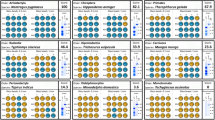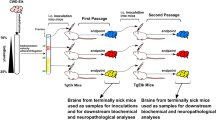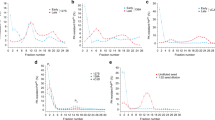Abstract
Prions are self-replicating proteins that can cause neurodegenerative disorders such as bovine spongiform encephalopathy (also known as mad cow disease). Aberrant conformations of prion proteins accumulate in the central nervous system, causing spongiform changes in the brain and eventually death. Since the inception of the prion hypothesis — which states that misfolded proteins are the infectious agents that cause these diseases — researchers have sought to generate infectious proteins from defined components in the laboratory with varying degrees of success. Here, we discuss several recent studies that have produced an array of novel prion strains in vitro that exhibit increasingly high titres of infectivity. These advances promise unprecedented insight into the structure of prions and the mechanisms by which they originate and propagate.
This is a preview of subscription content, access via your institution
Access options
Subscribe to this journal
Receive 12 print issues and online access
$209.00 per year
only $17.42 per issue
Buy this article
- Purchase on Springer Link
- Instant access to full article PDF
Prices may be subject to local taxes which are calculated during checkout


Similar content being viewed by others
References
Colby, D. W. & Prusiner, S. B. Prions. Cold Spring Harb. Perspect. Biol. 3, a006833 (2011).
Legname, G. et al. Synthetic mammalian prions. Science 305, 673–676 (2004).
Colby, D. W. et al. Protease-sensitive synthetic prions. PLoS Pathog. 6, e1000736 (2010).
Wang, F., Wang, X., Yuan, C.-G. & Ma, J. Generating a prion with bacterially expressed recombinant prion protein. Science 327, 1132–1135 (2010).
Colby, D. W. et al. Design and construction of diverse mammalian prion strains. Proc. Natl Acad. Sci. USA 106, 20417–20422 (2009).
Makarava, N. et al. Recombinant prion protein induces a new transmissible prion disease in wild-type animals. Acta Neuropathol. 119, 177–187 (2010).
Barria, M. A., Mukherjee, A., Gonzalez-Romero, D., Morales, R. & Soto, C. De novo generation of infectious prions in vitro produces a new disease phenotype. PLoS Pathog. 5, e1000421 (2009).
Deleault, N. R., Harris, B. T., Rees, J. R. & Supattapone, S. Formation of native prions from minimal components in vitro. Proc. Natl Acad. Sci. USA 104, 9741–9746 (2007).
Pattison, I. H. & Millson, G. C. Scrapie produced experimentally in goats with special reference to the clinical syndrome. J. Comp. Pathol. 71, 101–108 (1961).
Prusiner, S. B. Molecular biology of prion diseases. Science 252, 1515–1522 (1991).
Bessen, R. A. & Marsh, R. F. Biochemical and physical properties of the prion protein from two strains of the transmissible mink encephalopathy agent. J. Virol. 66, 2096–2101 (1992).
Telling, G. C. et al. Evidence for the conformation of the pathologic isoform of the prion protein enciphering and propagating prion diversity. Science 274, 2079–2082 (1996).
Legname, G. et al. Continuum of prion protein structures enciphers a multitude of prion isolate-specified phenotypes. Proc. Natl Acad. Sci. USA 103, 19105–19110 (2006).
Wickner, R. B. [URE3] as an altered URE2 protein: evidence for a prion analog in Saccharomyces cerevisiae. Science 264, 566–569 (1994).
Patino, M. M., Liu, J.-J., Glover, J. R. & Lindquist, S. Support for the prion hypothesis for inheritance of a phenotypic trait in yeast. Science 273, 622–626 (1996).
Tanaka, M., Chien, P., Naber, N., Cooke, R. & Weissman, J. S. Conformational variations in an infectious protein determine prion strain differences. Nature 428, 323–328 (2004).
Tanaka, M., Collins, S. R., Toyama, B. H. & Weissman, J. S. The physical basis of how prion conformations determine strain phenotypes. Nature 442, 585–589 (2006).
Derkatch, I. L., Chernoff, Y. O., Kushnirov, V. V., Inge-Vechtomov, S. G. & Liebman, S. W. Genesis and variability of [PSI] prion factors in Saccharomyces cerevisiae. Genetics 144, 1375–1386 (1996).
Speransky, V. V., Taylor, K. L., Edskes, H. K., Wickner, R. B. & Steven, A. C. Prion filament networks in [URE3] cells of Saccharomyces cerevisiae. J. Cell Biol. 153, 1327–1336 (2001).
Tessier, P. M. & Lindquist, S. Prion recognition elements govern nucleation, strain specificity and species barriers. Nature 447, 556–561 (2007).
Wille, H., Baldwin, M. A., Cohen, F. E., DeArmond, S. J. & Prusiner, S. B. in CIBA Foundation Symposium No. 199: the Nature and Origins of Amyloid Fibrils. 181–201 (John Wiley & Sons, Chichester, 1996).
Colby, D. W. et al. Prion detection by an amyloid seeding assay. Proc. Natl Acad. Sci. USA 104, 20914–20919 (2007).
King, C. Y. & Diaz-Avalos, R. Protein-only transmission of three yeast prion strains. Nature 428, 319–323 (2004).
Kocisko, D. A. et al. Cell-free formation of protease-resistant prion protein. Nature 370, 471–474 (1994).
Castilla, J., Saa, P., Hetz, C. & Soto, C. In vitro generation of infectious scrapie prions. Cell 121, 195–206 (2005).
Hsiao, K. K. et al. Spontaneous neurodegeneration in transgenic mice with mutant prion protein. Science 250, 1587–1590 (1990).
Kaneko, K. et al. A synthetic peptide initiates Gerstmann–Sträussler–Scheinker (GSS) disease in transgenic mice. J. Mol. Biol. 295, 997–1007 (2000).
Tremblay, P. et al. Mutant PrPSc conformers induced by a synthetic peptide and several prion strains. J. Virol. 78, 2088–2099 (2004).
Legname, G. et al. Strain-specified characteristics of mouse synthetic prions. Proc. Natl Acad. Sci. USA 102, 2168–2173 (2005).
Gambetti, P. et al. A novel human disease with abnormal prion protein sensitive to protease. Ann. Neurol. 63, 697–708 (2008).
Ayers, J. I. et al. The strain-encoded relationship between PrP replication, stability and processing in neurons is predictive of the incubation period of disease. PLoS Pathog. 7, e1001317 (2011).
McKinley, M. P., Bolton, D. C. & Prusiner, S. B. A protease-resistant protein is a structural component of the scrapie prion. Cell 35, 57–62 (1983).
May, B. C. H., Govaerts, C., Prusiner, S. B. & Cohen, F. E. Prions: so many fibers, so little infectivity. Trends Biochem. Sci. 29, 162–165 (2004).
Kimberlin, R. & Walker, C. Characteristics of a short incubation model of scrapie in the golden hamster. J. Gen. Virol. 34, 295–304 (1977).
Kim, J. I. et al. Mammalian prions generated from bacterially expressed prion protein in the absence of any mammalian cofactors. J. Biol. Chem. 285, 14083–14087 (2010).
Piening, N., Weber, P., Giese, A. & Kretzschmar, H. Breakage of PrP aggregates is essential for efficient autocatalytic propagation of misfolded prion protein. Biochem. Biophys. Res. Commun. 326, 339–343 (2005).
Flint, E. B. & Suslick, K. S. The temperature of cavitation. Science 253, 1397–1399 (1991).
Mark, G. et al. OH-radical formation by ultrasound in aqueous solution – Part II: Terephthalate and Fricke dosimetry and the influence of various conditions on the sonolytic yield. Ultrason. Sonochem. 5, 41–52 (1998).
Stathopulos, P. B. et al. Sonication of proteins causes formation of aggregates that resemble amyloid. Protein Sci. 13, 3017–3027 (2004).
Price, G. J. & Smith, P. F. Ultrasonic degradation of polymer solutions: 2. The effect of temperature, ultrasound intensity and dissolved gases on polystyrene in toluene. Polymer 34, 4111–4117 (1993).
Meyer-Luehmann, M. et al. Exogenous induction of cerebral β-amyloidogenesis is governed by agent and host. Science 313, 1781–1784 (2006).
Li, J. Y. et al. Lewy bodies in grafted neurons in subjects with Parkinson's disease suggest host-to-graft disease propagation. Nature Med. 14, 501–503 (2008).
Kordower, J. H., Chu, Y., Hauser, R. A., Freeman, T. B. & Olanow, C. W. Lewy body-like pathology in long-term embryonic nigral transplants in Parkinson's disease. Nature Med. 14, 504–506 (2008).
Prusiner, S. B. et al. Scrapie prions aggregate to form amyloid-like birefringent rods. Cell 35, 349–358 (1983).
Glenner, G. G. & Wong, C. W. Alzheimer's disease: initial report of the purification and characterization of a novel cerebrovascular amyloid protein. Biochem. Biophys. Res. Commun. 120, 885–890 (1984).
Masters, C. L. et al. Amyloid plaque core protein in Alzheimer disease and Down syndrome. Proc. Natl Acad. Sci. USA 82, 4245–4249 (1985).
Goate, A. et al. Segregation of a missense mutation in the amyloid precursor protein gene with familial Alzheimer's disease. Nature 349, 704–706 (1991).
Hardt, F. & Ranlov, P. Transfer amyloidosis. Int. Rev. Exp. Pathol. 16, 273–334 (1976).
Axelrad, M. A., Kisilevsky, R., Willmer, J., Chen, S. J. & Skinner, M. Further characterization of amyloid-enhancing factor. Lab. Invest. 47, 139–146 (1982).
Ganowiak, K., Hultman, P., Engstrom, U., Gustavsson, A. & Westermark, P. Fibrils from synthetic amyloid-related peptides enhance development of experimental AA-amyloidosis in mice. Biochem. Biophys. Res. Commun. 199, 306–312 (1994).
Geula, C. et al. Aging renders the brain vulnerable to amyloid β-protein neurotoxicity. Nature Med. 4, 827–831 (1998).
Gotz, J., Chen, F., van Dorpe, J. & Nitsch, R. M. Formation of neurofibrillary tangles in P301L tau transgenic mice induced by Aβ 42 fibrils. Science 293, 1491–1495 (2001).
Perutz, M. F. & Windle, A. H. Cause of neural death in neurodegenerative diseases attributable to expansion of glutamine repeats. Nature 412, 143–144 (2001).
Frost, B., Jacks, R.L. & Diamond, M.I. Propagation of tau misfolding from the outside to the inside of a cell. J. Biol. Chem. 284, 12845–12852 (2009).
Lee, H.-J. et al. Assembly-dependent endocytosis and clearance of extracellular α-synuclein. Int. J. Biochem. Cell Biol. 40, 1835–1849 (2008).
Yang, W., Dunlap, J. R., Andrews, R. B. & Wetzel, R. Aggregated polyglutamine peptides delivered to nuclei are toxic to mammalian cells. Hum. Mol. Genet. 11, 2905–2917 (2002).
Ren, P. H. et al. Cytoplasmic penetration and persistent infection of mammalian cells by polyglutamine aggregates. Nature Cell Biol. 11, 219–225 (2009).
Sung, J. Y. et al. Induction of neuronal cell death by Rab5A-dependent endocytosis of α-synuclein. J. Biol. Chem. 276, 27441–27448 (2001).
Desplats, P. et al. Inclusion formation and neuronal cell death through neuron-to-neuron transmission of α-synuclein. Proc. Natl Acad. Sci. USA 106, 13010–13015 (2009).
Truant, R., Atwal, R. S., Desmond, C., Munsie, L. & Tran, T. Huntington's disease: revisiting the aggregation hypothesis in polyglutamine neurodegenerative diseases. FEBS J. 275, 4252–4262 (2008).
Nelson, R. et al. Structure of the cross-β spine of amyloid-like fibrils. Nature 435, 773–778 (2005).
Wasmer, C. et al. Amyloid fibrils of the HET-s(218–289) prion form a β solenoid with a triangular hydrophobic core. Science 319, 1523–1526 (2008).
Toyama, B. H., Kelly, M. J., Gross, J. D. & Weissman, J. S. The structural basis of yeast prion strain variants. Nature 449, 233–237 (2007).
Wille, H. et al. Natural and synthetic prion structure from X-ray fiber diffraction. Proc. Natl Acad. Sci. USA 106, 16990–16995 (2009).
Shorter, J. & Lindquist, S. Hsp104 catalyzes formation and elimination of self-replicating Sup35 prion conformers. Science 304, 1793–1797 (2004).
Telling, G. C. et al. Prion propagation in mice expressing human and chimeric PrP transgenes implicates the interaction of cellular PrP with another protein. Cell 83, 79–90 (1995).
Cello, J., Paul, A. V. & Wimmer, E. Chemical synthesis of poliovirus cDNA: generation of infectious virus in the absence of natural template. Science 297, 1016–1018 (2002).
Kornberg, A. & Baker, T. A. DNA Replication (W. H. Freeman, New York, 1992).
Saborio, G. P., Permanne, B. & Soto, C. Sensitive detection of pathological prion protein by cyclic amplification of protein misfolding. Nature 411, 810–813 (2001).
Acknowledgements
This work was supported by grants from the US National Institutes of Health (AG021601, AG02132, AG010770 and AG031220) as well as by gifts from the G. Harold and Leila Y. Mathers Charitable Foundation, the Sherman Fairchild Foundation and R. Galvin.
Author information
Authors and Affiliations
Corresponding author
Ethics declarations
Competing interests
The authors declare no competing financial interests.
Related links
Related links
FURTHER INFORMATION
Institute for Neurodegenerative Diseases, University of California, San Francisco
Glossary
- Aβ
-
A short peptide that is cleaved from amyloid precursor protein and forms the amyloid plaques that are found in Alzheimer's disease.
- α-synuclein
-
A protein expressed primarily in neurons and can aggregate to form Lewy bodies (abnormal protein aggregates inside nerve cells), which are found in Parkinson's disease and dementia with Lewy bodies.
- Gerstmann–Sträussler–Scheinker syndrome
-
A genetic neurodegenerative disease in humans that is caused by mutations in the PRNP gene, which encodes the prion protein (PrP).
- Huntingtin
-
A protein that may have a role in microtubule-mediated transport or vesicle function. The expanded polyglutamine repeats within huntingtin cause Huntington's disease.
- Microtubule-associated protein tau
-
A protein that is expressed primarily in neurons and promotes microtubule assembly and stability.
- Prion protein
-
(PrP). A glycosyl phosphatidylinositol-anchored membrane protein that is expressed in many organs and is required for the development of prion diseases. The normal function of PrP is unknown.
- Systemic amyloidosis
-
A disease in which amyloid is deposited in various organs outside the central nervous system.
- Synthetic prions
-
Infectious proteins that can be created from minimal components in the laboratory and demonstrate infectivity in living organisms.
- Tauopathies
-
Neurodegenerative diseases that are caused by the misprocessing and aggregation of microtubule-associated protein tau, which results in neurofibrillary tangles, paired helical filaments and/or Pick bodies (silver-staining, spherical protein aggregations) in the brain.
Rights and permissions
About this article
Cite this article
Colby, D., Prusiner, S. De novo generation of prion strains. Nat Rev Microbiol 9, 771–777 (2011). https://doi.org/10.1038/nrmicro2650
Published:
Issue Date:
DOI: https://doi.org/10.1038/nrmicro2650
This article is cited by
-
Propagation of PrPSc in mice reveals impact of aggregate composition on prion disease pathogenesis
Communications Biology (2023)
-
Exogenous Aβ seeds induce Aβ depositions in the blood vessels rather than the brain parenchyma, independently of Aβ strain-specific information
Acta Neuropathologica Communications (2021)
-
Atomic-level differences between brain parenchymal- and cerebrovascular-seeded Aβ fibrils
Scientific Reports (2021)
-
Functional genomics screen identifies proteostasis targets that modulate prion protein (PrP) stability
Cell Stress and Chaperones (2021)
-
FRET-based Tau seeding assay does not represent prion-like templated assembly of Tau filaments
Molecular Neurodegeneration (2020)



